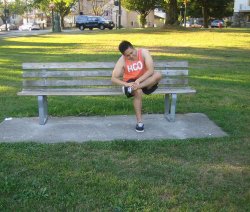Shin splints are sports injuries that happen due to overexerting of the body especially running exercises. Pain can be felt along the tibia caused by swelling of the muscles or even a stress fracture.
[youtube url=”https://www.youtube.com/watch?v=Sg3WjVce4Zk”]Shin splints is also called medial tibial stress syndrome which happens in athletes who intensify or change their training routines. This results to overworked tendons, muscles and tissues of the bone due to increased activity.
Symptoms of shin splints
- Pain when walking or running
- Tenderness and pain can be felt in the lower half of the legs especially the lower third of the shins near the Achilles tendon.
- Pain can be felt when standing for extended periods
- Bone and joint pain becomes severe when performing exercises
- Small bumps or bruising on the shins
Tenderness and pain can be felt in the lower half of the legs especially the lower third of the shins near the Achilles tendon.
Treatment
- Take plenty of rest to allow the swollen muscles and the shin bone time to heal. Avoid running, sprinting or walking too fast while the shin bone is still in the healing process. Perform low impact exercises such as swimming and biking.
- Apply an ice pack on the shin every 20-minute intervals to lessen the inflammation and pain. Avoid placing the ice pack directly on the skin to prevent frostbite and making the condition worse. Wrap the pack using a thin towel or a face cloth before placing on the affected area.
- Take the prescribed non-steroidal anti-inflammatory medication such as ibuprofen, naproxen and aspirin to lessen the pain and inflammation.
- Perform stretching in the morning before starting activities. Perform a stair stretch by standing on a chair so that the toes will hang on the edge. Point the toes down and stretch them toward the ceiling. Repeat this exercise at least 20 times with intervals of rest for a few seconds. Stretch the affected area by kneeling and the top area of the feet is flat against the floor and slowly sit on the chair and a stretch can be felt in the shin muscles.
- Perform exercises by strengthening the shin muscles by sitting in a chair and using the toes trace shapes or the alphabets on the floor. Another exercise is by walking in the heels for at least 30 seconds at a time and switch to regular walking for 30 seconds. Repeat this procedure at least 3-4 times every day.
- Start running slowly and increase the distance by at least 10% every week and if pain is starting to come back, stop the exercise.
Tips
- Make it a habit of warming up before starting to run, sprinting or playing sports such as basketball and soccer that requires footwork. Perform a one-mile jog before starting the longer runs. Another is by walking briskly for a block or two before starting a run.
- Perform workouts on soft surfaces, avoid running on pavement or concrete. Run on dirt paths or grass. If there is a need to run on the road, mix it up by swimming or biking.

